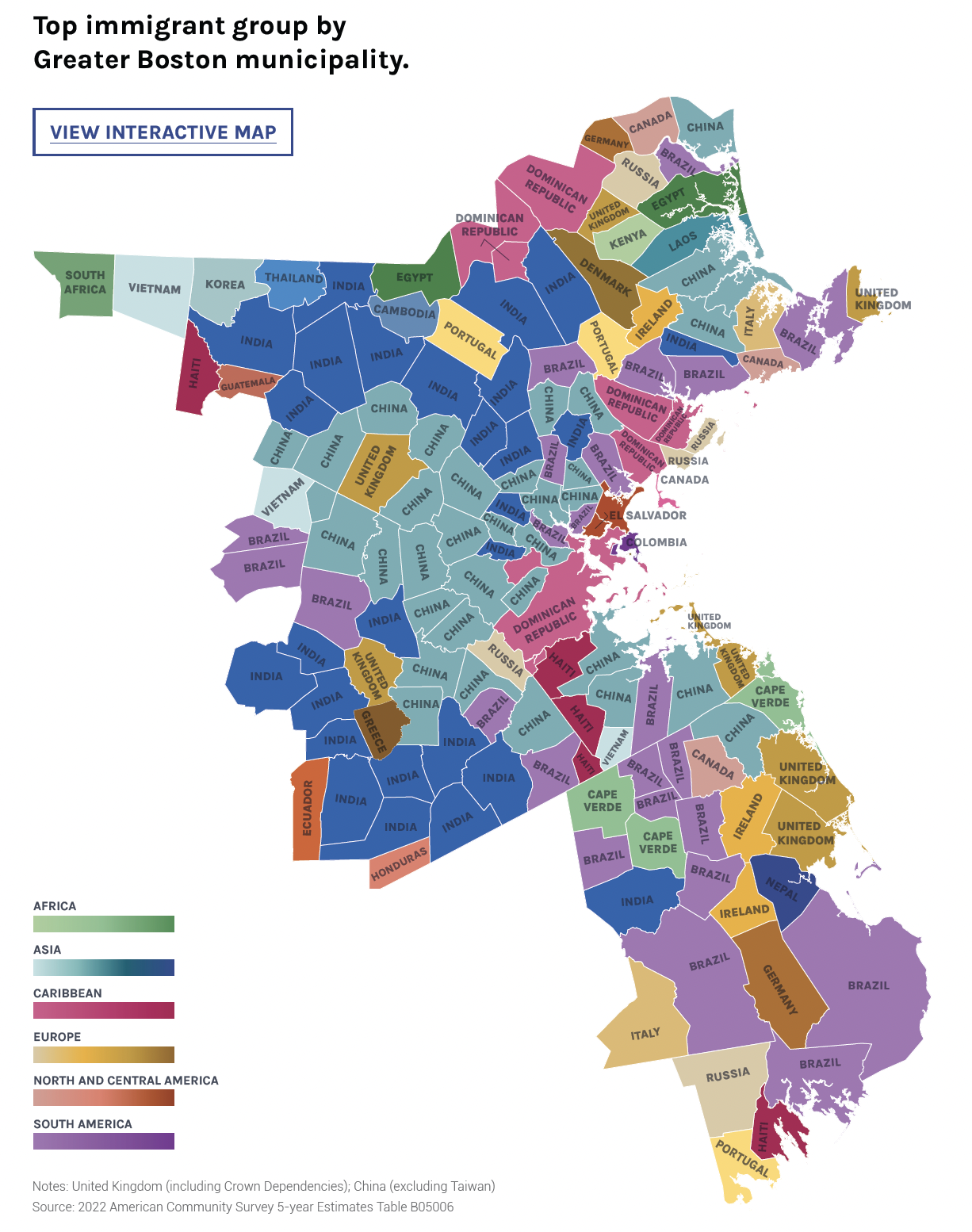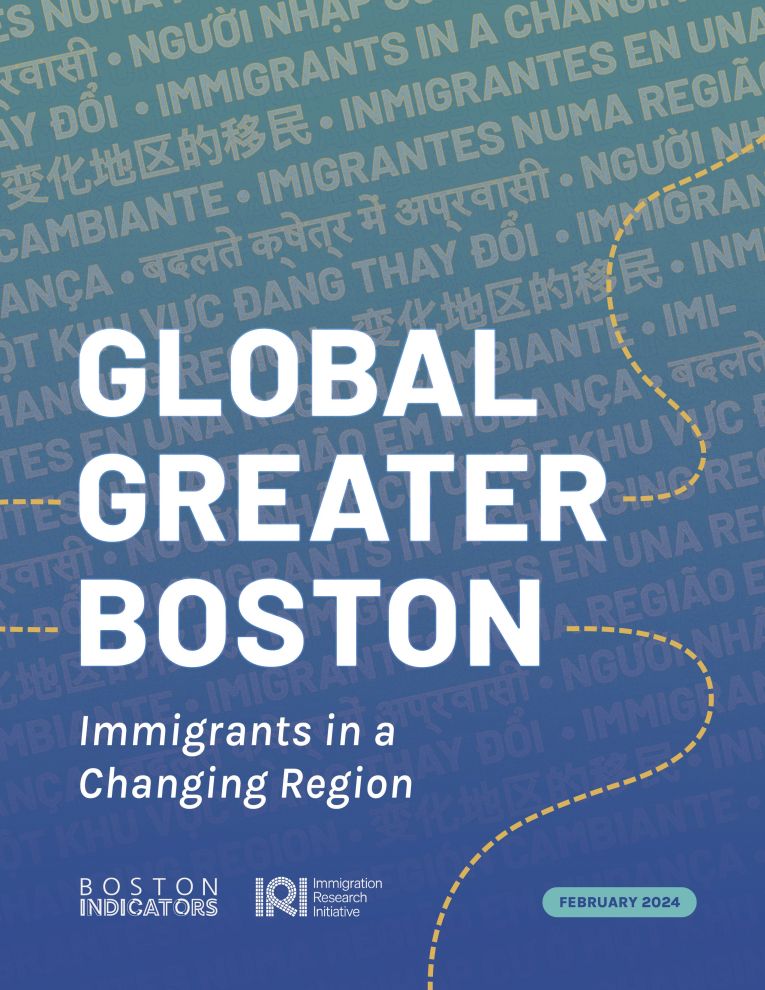New report explores the diversity and economic impact of Greater Boston’s diverse immigrant community
Data capture a changing immigrant population with a $100 billion annual impact on Greater Boston
February 14, 2024
Boston – A new report from Boston Indicators, in collaboration with the Immigration Research Initiative, captures the remarkable changes in Greater Boston’s immigrant population over the past few decades and the remarkable impact these immigrants are having in both high-wage and low-wage employment sectors.
The new report, Global Greater Boston: Immigrants in a Changing Region, highlights the transformation of Greater Boston’s immigrant pathways from Europe to Asia and Central and South America over the past 30 years. It also breaks down our immigrant communities to the town and country of origin level, exposing significant regional differences in where immigrants from all over the world are choosing to live and raise families.
“We have always thought of Boston as a city of immigrants, but this report peels back some of the misconceptions about who our immigrant communities are today,” said Luc Schuster, Executive Director of Boston Indicators. “More importantly, it captures how immigrants contribute more than their share in the Greater Boston economy and drive our Main Street business economy in many communities.”
A changing immigrant population moving beyond the urban core
The report first dives into the demographics of immigration into Greater Boston, looking more closely at the countries of origin of the region’s immigrant communities. The data capture a remarkable shift since 1990 from a largely Eurocentric immigrant influx to one led by tens of thousands of Asian immigrants from China, India, and Vietnam, along with Latino immigrants from the Dominican Republic, El Salvador, and Guatemala, and thousands of people from Brazil and Haiti.
Top 10 countries of origin, 1990

Top 10 countries of origin, 2021

It is a vastly different makeup from elsewhere in the United States. Whereas nearly one in four immigrants nationwide are Mexican, for example, just one percent are in Greater Boston. Greater Boston is home to the majority (58 percent) of all immigrants from Cape Verde in the U.S., 12 percent of Brazilian immigrants, and 9 percent of Irish immigrants.
“The unique mix of immigrants does more than give Boston a different character; it also continues to be vital in making up slower growth in U.S. born migration into Boston and a net outmigration to other regions of the country,” noted Schuster.

As immigration has grown across the region, some of the most noticeable growth has happened outside Boston proper, as high housing and other costs push immigrants out of the urban core. Places like Revere (+11 percentage point increase in foreign-born population), Boxborough (+9 percentage points), Marlborough (+8 percentage points), and Brockton (+8 percentage points) showed some of the most notable growth from 2011-2021.
Data also show marked regional differences between the immigrant communities in the region. While Chinese and Indian immigrants make up the largest immigrant populations in many Greater Boston suburbs, the map shows concentrations of Latino groups in Boston proper and the Merrimack Valley, and a growing influx of Brazilian and Cape Verdean immigrants in Plymouth County and western Middlesex County.
A diverse, upwardly mobile population with a significant economic role
That geographic diversity is paralleled by immigrants' diverse and impactful roles in the economy and labor force. Taken as a single group, immigrants contribute roughly $103 billion annually, about 21 percent of regional GDP, and comprise 28 percent of all business owners. In addition, 60 percent have some level of education post-high school. However, broken down more granularly, there are wide education disparities among immigrants from different countries. Among the top five countries of origin, 91 percent of immigrants from India and over 60 percent from China have a Bachelor’s Degree or higher, versus less than a quarter of Dominican, Brazilian, and Haitian immigrants.
While Black and Latino immigrants tend to earn lower wages than White and AAPI immigrants, the data suggest that all groups show robust economic mobility the longer they stay and work in the country. Immigrants in Greater Boston who have been in the U.S. for less than five years and work full-time make a median wage of $50,000. For those who have lived in the U.S. for over a decade, the median salary climbs to $58,000. For the second generation, the upward trend is more striking – the median individual income for second-generation Bostonians from immigrant families is $79,000 compared to just $36,000 for their first-generation parents.

Understanding immigration pathways
At a time when the asylum, refugee, and immigration systems are driving news coverage and challenging the nation’s immigration system, the report concludes with a primer on immigration pathways, explaining some common ways that immigrants arrive in the region. More than three-quarters of immigrants in Greater Boston arrive and stay on temporary visas from several programs for tourists, workers, students, and other exchange visitors.
Immigration Research Initiative (IRI) is a nonprofit, nonpartisan think tank on immigrant integration, looking at issues of economic, social, and cultural inclusion of immigrants in the United States. IRI is attentive to how immigrants fare in the United States and to how the receiving communities fare as they change, with particular attention to the implications for race, gender, and income equity. IRI is a fiscally sponsored project of NEO Philanthropy.

